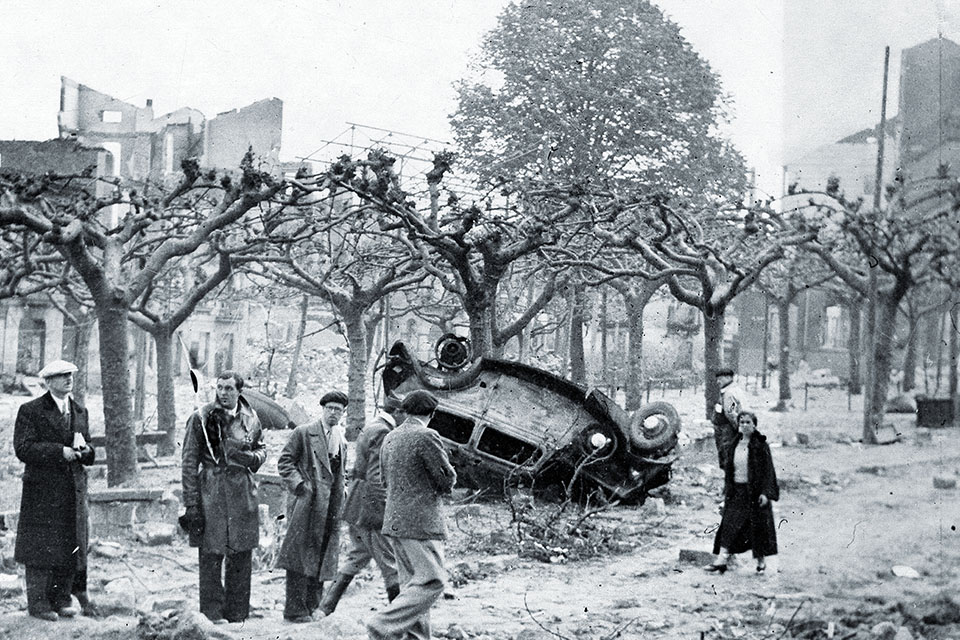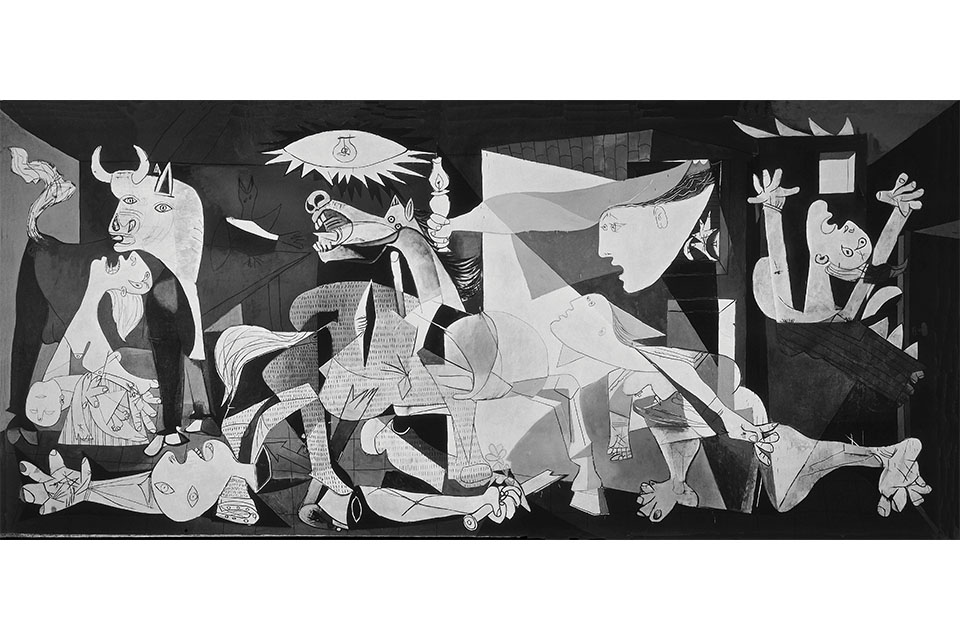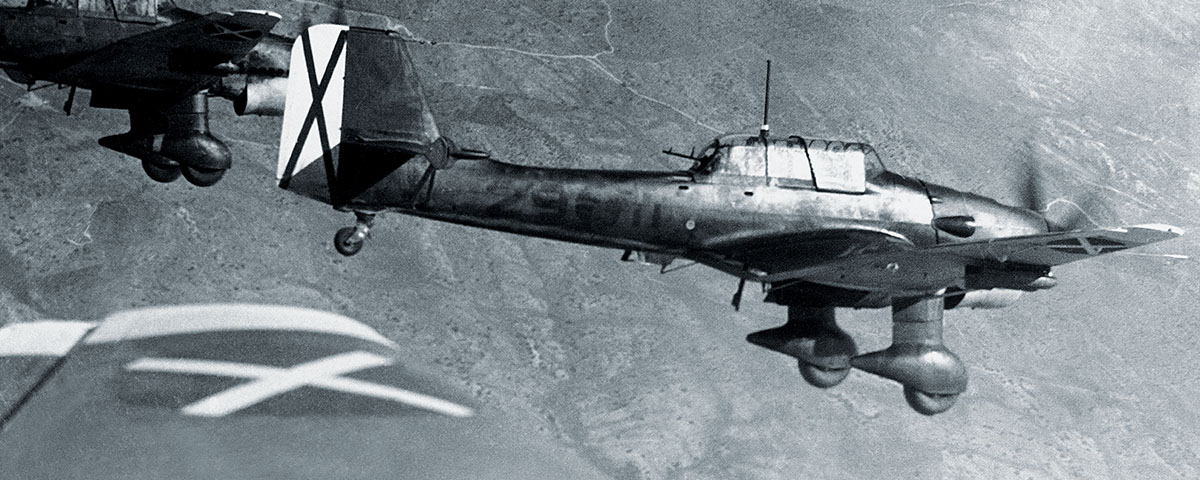Oftentimes in the history of human conflict just the mention of a battleground—Thermopylae, Waterloo, Normandy—carries a weight beyond the written word. Guernica is one such name in modern military history. The 1936–39 Spanish Civil War took a brutal turn with the April 26, 1937, bombing of that Republican-held medieval Basque town by German and Italian planes with the permission of Nationalist Generalissimo Francisco Franco.
Some sources claim the town was packed with farmers and shoppers who’d gravitated from the surrounding area for the traditional Monday market day. Some were present, though the Basque government had earlier called a halt to market days to limit wartime traffic on surrounding roads. Incendiary bombs, which burst into flames on impact, caused much of the damage. Survivors spoke of aircraft strafing the roads with machine-gun fire in the aftermath of the bomb runs. Though casualties in Guernica—in comparison to those sustained in similar bombings during both world wars—were relatively light (fewer than 300 killed is the estimate accepted by most historians), most of those killed were reportedly civilians. That fact alone boosted its propaganda value, and just over a year later Spanish cubist artist Pablo Picasso, who supported the Republican cause, gave the world his take on the tragedy—a stark gray, black and white melee of fire, smoke, screaming figures and dismembered limbs. A tapestry copy of his 25½-by-11½-foot oil Guernica hangs symbolically outside the Security Council room at the United Nations headquarters in New York.
The Spanish Civil War was fought between Republicans, loyal to the left-wing coalition government that came to power in a February 1936 general election, and rebel right-wing Nationalists, led by Franco. It was also a proxy war between rival nations allied with Spain’s various ideological factions. Flouting a nonintervention agreement brokered by the lame-duck League of Nations, fascist Germany and Italy supported the Nationalists, while the communist Soviet Union aided the Republicans. (Still other nations chipped in covert aid in the form of money and materiel.) It would be wrong, however, to suppose that the fiercely independent Spanish were mere puppets of the dictators.
The Soviet Union sent the Republican government weapons—more than 600 aircraft, a few hundred tanks, upward of 1,000 artillery pieces and some half-million rifles—as well as several thousand military advisers, including pilots and tank commanders. The Soviets also directed the Communist International to rally paramilitary “International Brigades” to the Republican side, including the noted Abraham Lincoln Brigade from the United States. While the League of Nations maintained its noninterventionist stance, late in the war it did agree to help move treasured artworks recovered from Spain’s national Museo del Prado in Madrid (to which the Republican government had named Picasso director in absentia) to the sanctuary of Geneva, Switzerland.
Adolf Hitler’s involvement may not have been simply blatant opportunism, but born from fear of encirclement, given the left-wing governments in both Spain and France and the specter of Soviet Russia to his east. Hitler seized on Western democracies’ desire to avoid war, which left him an almost free hand to assist Franco, as well as a heaven-sent opportunity for his Luftwaffe to experiment with new tactics and planes (the single-engine Junkers Ju 87 Stuka among them). At the outset of World War II in 1939 German pilots rolled over all comers, having had plentiful combat experience.
The Soviets also exploited Spain as a training ground, Red Army pilots and tankers gaining vital experience as they field-tested their respective weapons, an exercise they would repeat in China.
As the ideological clash in Spain flared into violence, the war began on July 17, 1936, with an uprising of Spanish army generals led by José Sanjurjo, who died in a plane crash three days later, leaving Franco in command of Nationalist forces. Under the generalissimo the rebels advanced from strongholds in southern and western Spain. By the spring of 1937 a determined army of 100,000 Nationalists, joined by a corps of 60,000 Italian volunteers, was marching on the Basque region of northern Spain.
The Basques have long prized their autonomy, from their distant origins as the oldest of Europeans with their own language to the more recent separatist activities of the revolutionary socialist ETA. The iconic symbol of their independent spirit is the lauburu, or Basque cross, which ironically resembles a Nazi swastika, bearing four comma-shaped arms. Under the Republicans the Basques, though conservative and strongly Catholic, enjoyed a measure of self-determination, their reward for tacitly supporting the government. Bilbao, the economic heart of Basque country and the greatest industrial prize in the north, had come under air attack by late August 1936.
The Nationalists supported their push to Spain’s northern coast with a blockade of all Basque ports. Although the odd cargo ship managed to sneak through, official British policy adhered to the League of Nations protocol of nonintervention. Conservative statesman and future Prime Minister Winston Churchill mandated “an absolutely rigid neutrality, with the strongest protest against any breach of it.” Recognition of either side as a belligerent would subject British ships to being stopped and searched en route to Spain. A rather unsatisfactory standoff left its merchant vessels holed up in Saint-Jean-de-Luz in the Basque country of France. That situation lasted until April 20, when the British merchantman Seven Seas Spray ignored its own government and headed into Bilbao. Other ships followed. Bilbao would not be starved into submission.
That same day the Nationalists resumed their offensive, smashing into the Republicans and prompting demoralized troops to fall back en masse in search of a safe haven. On the 25th they began flooding into Guernica, some 6 miles behind the front line.
For the Basques, Guernica’s significance went far beyond its strategic import as the last town between the marauding Nationalists and Bilbao. Symbolically and historically, it was the ancestral home of their centuries-old democracy. That wouldn’t save it from the whirlwind headed its way. German and Italian aircraft had bombed Durango on March 31. Guernica was next in line.
As the northern bastion of Republican resistance and epicenter of Basque culture, Guernica’s value as a Nationalist target was all too clear. Franco himself had little airpower to devote to such an operation, but the Germans were all too willing to step in. The Condor Legion, an adjunct of the Luftwaffe commanded by Colonel Wolfram von Richthofen—a cousin of Manfred von Richthofen, the “Red Baron” of World War I fame—would give the world another foretaste of how Germany’s blitzkrieg tactics would operate during the early phases of World War II. The inhabitants of Guernica were to be the unwitting guinea pigs as the fascists determined what it would take to bomb a city into oblivion.
No one should have been surprised. Two years earlier retired German General Erich Ludendorff, the victor of Tannenberg in 1914, had published Der totale Krieg (The Total War), in which he argued that in such a conflict the distinction between combatants and noncombatants was indistinguishable, and that civilian resources and infrastructure were legitimate military targets. It was said Richthofen selected Guernica, perhaps because it had been untouched by the war to that point, so the results of the bombing would be all the more apparent.
On the afternoon of April 26 the Nazi inferno swept down on Guernica. At 4:30 p.m. the bell in the Church of Santa María rang to warn of an air attack. Although Basque authorities had turned away many traders on the outskirts, some had made it into town for the market, complete with livestock. On hearing the alarm, townsfolk, itinerants and shell-shocked Republican soldiers headed for the designated basement refugios. It fell to a single Condor Legion Heinkel He 111 bomber to drop the first load, then depart.

People ventured out to help the stricken, only to be hit 15 minutes later by the full squadron, dropping various sizes and types of bombs. Panic ensued, as people considered whether the cellars or surrounding fields presented the safest option. As the hapless scattered, the strafing and grenading began, courtesy of Heinkel He 51C fighters. The lives of soldiers and civilians alike—men, women, children—were extinguished in a flash, no greater value put on them than farm animals that perished in the same indiscriminate onslaught (Picasso’s rendering prominently features a bull and a horse). But the worst was yet to descend.
Three-quarters of an hour after the initial assault the drone of engines announced the approach of Junkers Ju 52/3m transports turned medium bombers. Over the next two and a half hours, in 20-minute relays, three squadrons flying out of the Nationalist base at Burgos carpet-bombed Guernica. To the Germans it was merely the practical application of a military innovation of the Spanish Civil War.
It is hard to describe Armageddon. The planes rained missiles of all sizes, including 500-pound general-purpose bombs, anti-personnel 20-pounders and incendiaries in aluminum tubes that tumbled down like confetti at a wedding. There is something inherently callous about man’s ingenuity in wartime. Entire families were buried in rubble, animals incinerated and buildings smashed; only the church tower and Basque Parliament buildings remained undamaged amid the utter devastation.
Guernica’s population at the time was around 5,000, though retreating Republican troops and the market crowds had swelled the number of people in town to perhaps twice that. Total casualties are hard to pin down, though most historians have settled on a death toll of between 150 and 300 people, with hundreds more injured. The planes had also laid waste to a broad swath of the town center. In his memoirs of World War II Churchill described Guernica as a “defenseless little township” and the German actions as “experimental horrors.”
Propaganda always plays a part in war, and Republicans and Nationalists alike rushed to control the narrative. One Nationalist take posited that Guernica’s own defenders had fired the town as they withdrew—the kind of scorched-earth policy of which Soviet dictator Joseph Stalin would approve. Franco specifically blamed “Red hordes in the criminal service of [José Antonio] Aguirre,” president of the Provisional Government of the Basque Country. The Catholic Church, which sided with the Nationalists, backed the falsehood, going so far as to proclaim there was not a single German soldier on Spanish soil.
The Germans added their own slice to the misinformation cake. Condor Legion veterans later claimed they’d been trying to take out the Renteria Bridge, just outside Guernica, rather than the town itself, but that strong winds had blown their payloads onto the unfortunate citizens. Well, the bridge was undamaged, the winds absent, and anti-personnel bombs and machine-gun bullets are interesting weapons to deploy against a stone bridge. Another clearly fatuous claim suggested fog had grounded the planes, and that no attack had taken place.
In the end, the evidence pointed to the bombing of Guernica as a planned attack against human beings—an act of terror and a grim foretaste of what was to come in World War II. Almost immediately it became the symbolic act that defined the greater atrocity—a calculated attack on a town or city crowded with civilians.
It wasn’t just the act, however, but the reporting of it that made such a splash across international headlines. London Times correspondent George Steer was in nearby Bilbao with fellow reporters when Guernica was bombed. Late that evening they drove east to the beleaguered town to record the devastation. Their visit gave us the words to describe the blazing ruins, nine in 10 houses beyond repair, squares filled with wounded lying atop tables and mattresses, dazed and horror-struck people. Amid the rubble lay incendiary canisters bearing the names of German manufacturers. Steer returned the following morning for a second look before filing his copy. Four days after the attack a rally at London’s Royal Albert Hall organized by the pacifist League of Nations Union roundly condemned what had occurred. Within weeks British cinemas were screening newsreel footage of the bombing aftermath.

Australian reporter Noel Monks was covering the war for the London Daily Express. Alerted to the bombing by a government official, he drove toward Guernica that evening, noting flames reflected in the sky while still a good 10 miles from town. On reaching Guernica, though nauseated by “the smell of burning human flesh,” he helped collect charred bodies and looked on as buildings collapsed in on themselves. In the town plaza he encountered sobbing survivors, rocking to and fro amid the wall of flames.
After the horror of Guernica the Republicans could only fall back on Bilbao and its Iron Ring network of fortifications, comprising concentric rings of tunnels, bunkers and trenches in a 50-mile perimeter around the city. But the defenses were incomplete, and Basque informants eager to end the bloodshed had reportedly betrayed its plans to the Nationalists. Bilbao fell on June 19.
Guernica inspired widespread revulsion abroad. In fact, for Republicans the bombing represented their greatest propaganda coup, with any number of ready-made martyrs. It made little difference. Ultimately the spoils of war went to the Nationalists, and Franco embarked on a lengthy dictatorship that ended with his death on Nov. 20, 1975—but not before he restored the monarchy, naming Juan Carlos I his successor.
The international scrutiny garnered by Guernica coverage may have limited the scope of reprisals against Republicans after the war. But Franco’s regime found ways of hitting back at the Basques, making every effort to crush their independent spirit. It outlawed the Basque flag and suppressed the use of the Basque language. “If you are Spanish, speak Spanish,” went the new mantra.
The Spanish Civil War, meanwhile, took on greater significance for many people, particularly those on the left, who claimed it was the opening salvo of World War II, a war in which carpet-bombing by both sides claimed many more Guernicas and was a significant contributor to the war’s death toll of more than 60 million. Others considered the Second Sino-Japanese War, which broke out in July 1937, the opening shot. The same writers, photographers and filmmakers turned up in both war zones.
Among the best-known correspondents in Spain was Ernest Hemingway, who while the civil war still raged wrote The Fifth Column, his only full-length play, which accurately reflected the paranoia that gripped communities post-Guernica. The phrase, used to describe the spies and saboteurs who would betray cities to the enemy, has been attributed to Nationalist General Emilio Mola, Franco’s colleague, who in October 1936 boldly claimed he had four columns waiting to march on Madrid, with a fifth inside the city, ready and poised to rise up. (Like rebel leader José Sanjurjo, Mola also didn’t survive the war, having died in a plane crash on June 3, 1937, scarcely a month after the bombing of Guernica.)
Another consequence of Allied inactivity over Spain was that it left Hitler and Italian dictator Benito Mussolini with the false impression they had a free hand, as democracies seemingly lacked the will to call their bluff. While the conflict left many in the West divided, there was no such soul-searching in Germany. Appeasement overlapped with the civil war, and another, far greater catastrophe lay on the horizon. While British Prime Minister Neville Chamberlain negotiated with Hitler, keen to avoid a British Guernica, the RAF steeled itself for war, its modernization given fresh impetus by the telltale events in Spain.
On Oct. 23, 1940, Hitler ventured to a railway station on the French-Spanish border to discuss strategy with Franco. The Führer, considering World War II already effectively won, wanted Spain to join the Axis in its fight against Britain, which stubbornly wouldn’t surrender. While Franco praised the German support he’d received, he was big on promises and small on commitment. Spain was worn out, impoverished even, after the civil war and would remain largely neutral during World War II.
Hitler, of course, was wrong about the outcome of World War II—one among many who had misread the significance of Guernica (and Nanjing, Warsaw and Rotterdam). The aerial destruction of Guernica did not intrinsically mean the bombing of civilians guaranteed capitulation and victory. On June 4, 1940, in anticipation of the coming Blitz, when London would suffer under its own rain of German bombs, Churchill delivered a pivotal speech to Parliament, articulating a mood of national defiance that resonated. Britain would “never surrender.”
Picasso’s Guernica endures. The artist completed the mural-sized oil in June 1937 for the International Exposition in Paris, where it was displayed in the Spanish pavilion to mixed reviews. The painting arrived in London on Sept. 30, 1938—the very day Chamberlain signed the Munich Agreement, hollowly promising “peace for our time.” Crowds grew larger as word of the painting spread, and when it appeared in East London’s White-
chapel Art Gallery for two weeks in January 1939, some 15,000 visitors came to see it. The price of admission? A pair of usable boots for a Republican soldier then defending what was left of the front.
On January 26 Barcelona fell to the Nationalists, and two months later, on March 28, Madrid itself capitulated. The Allies had failed to stop the juggernaut of fascism in Spain. Just three days after Madrid’s collapse Chamberlain issued a formal guarantee of Poland’s borders and said he expected Hitler to moderate his demands. Britain and France would soon have to fight.
Today Guernica is housed in Madrid’s Museo Reina Sofia, where each day more than 10,000 souls take in its screaming, surrealist figures. All these decades after Spain’s soul-rending conflict it retains that amount of cachet.
Stephen Roberts is a U.K.–based freelance writer and author. For further reading he recommends The Battle for Spain, by Antony Beevor; The Origins of the Second World War, by A.J.P. Taylor; and All Hell Let Loose, by Max Hastings.





